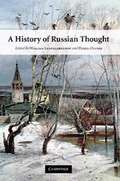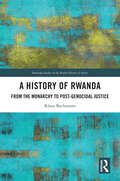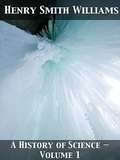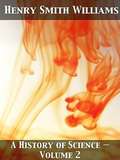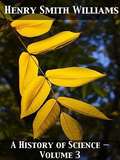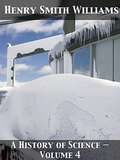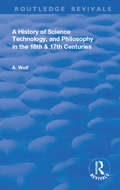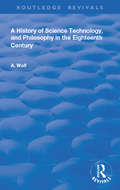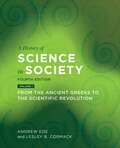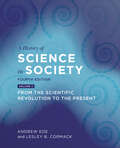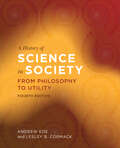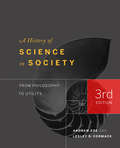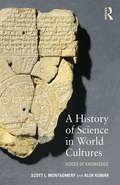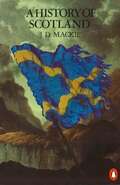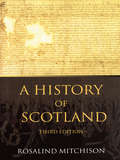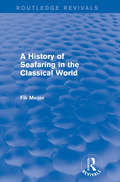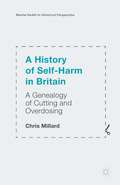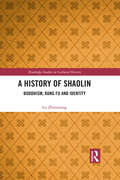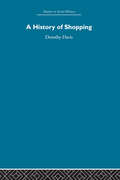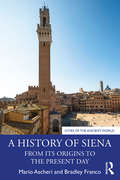- Table View
- List View
A History of Russian Thought
by William Leatherbarrow Derek Offord"The history of ideas has played a central role in Russia's political and social history. Understanding its intellectual tradition and the way the intelligentsia have shaped the nation is crucial to understanding the Russia of today. This new history examines important intellectual and cultural currents (the Enlightenment, nationalism, nihilism, and religious revival) and key themes (conceptions of the West and East, the common people, and attitudes to capitalism and natural science) in Russian intellectual history. Concentrating on the golden age of Russian thought in the mid-nineteenth-century, the contributors also look back to its eighteenth-century origins in the flowering of culture following the reign of Peter the Great, and forward to the continuing vitality of Russia's classical intellectual tradition in the Soviet and post-Soviet eras. With brief biographical details of over fifty key thinkers and an extensive bibliography, this book provides a fresh, comprehensive overview of Russian intellectual history"--Provided by publisher.
A History of Rwanda: From the Monarchy to Post-genocidal Justice (Routledge Studies in the Modern History of Africa)
by Klaus BachmannA History of Rwanda: From the Monarchy to Post-genocidal Justice provides a complete history of Rwanda, from the precolonial abanyiginya kingdom, through the German and Belgian colonial periods and subsequent independence, and then the devastating 1994 genocide and reconstruction, right up to the modern day. Based on extensive archival research, this book provides new insights and corrects many popular stereotypes about Rwanda, aiming to go beyond the polarized and heated debates focused on the genocide and the events that followed. Readers will get a clear and broad picture of Rwanda’s history and the social and political contexts that have defined the county from the pre-colonial period onwards. Embedding Rwanda’s history in the regional context, this book avoids simple moral judgements and instead shows where and when Rwanda differed from its neighbours and how the country’s history fits into larger debates about colonialism, genocide, ethnicity, race and development. Offering a full and balanced exploration of Rwanda’s rich and paradoxical history, this book will be an important read for researchers and students of African history, genocide studies, transitional justice, colonialism, and political and social anthropology.
A History of Science -- Volume 1
by Henry Smith Williams Edward Huntington WilliamsShould the story that is about to be unfolded be found to lack interest, the writers must stand convicted of unpardonable lack of art. <P> <P> Nothing but dulness in the telling could mar the story, for in itself it is the record of the growth of those ideas that have made our race and its civilization what they are; of ideas instinct with human interest, vital with meaning for our race; fundamental in their influence on human development; part and parcel of the mechanism of human thought on the one hand, and of practical civilization on the other. Such a phrase as “fundamental principles” may seem at first thought a hard saying, but the idea it implies is less repellent than the phrase itself, for the fundamental principles in question are so closely linked with the present interests of every one of us that they lie within the grasp of every average man and woman— nay, of every well-developed boy and girl. These principles are not merely the stepping-stones to culture, the prerequisites of knowledge— they are, in themselves, an essential part of the knowledge of every cultivated person
A History of Science -- Volume 2
by Henry Smith Williams Edward Huntington WilliamsThe studies of the present book cover the progress of science from the close of the Roman period in the fifth century A. D. to about the middle of the eighteenth century. In tracing the course of events through so long a period, a difficulty becomes prominent which everywhere besets the historian in less degree— a difficulty due to the conflict between the strictly chronological and the topical method of treatment. <P> <P> We must hold as closely as possible to the actual sequence of events, since, as already pointed out, one discovery leads on to another. But, on the other hand, progressive steps are taken contemporaneously in the various fields of science, and if we were to attempt to introduce these in strict chronological order we should lose all sense of topical continuity.
A History of Science -- Volume 3
by Henry Smith Williams Edward Huntington WilliamsWith the present book we enter the field of the distinctively modern. There is no precise date at which we take up each of the successive stories, but the main sweep of development has to do in each case with the nineteenth century. <P> <P> We shall see at once that this is a time both of rapid progress and of great differentiation. We have heard almost nothing hitherto of such sciences as paleontology, geology, and meteorology, each of which now demands full attention. Meantime, astronomy and what the workers of the elder day called natural philosophy become wonderfully diversified and present numerous phases that would have been startling enough to the star-gazers and philosophers of the earlier epoch.
A History of Science -- Volume 4
by Henry Smith Williams Edward Huntington WilliamsAS regards chronology, the epoch covered in the present volume is identical with that viewed in the preceding one. But now as regards subject matter we pass on to those diverse phases of the physical world which are the field of the chemist, and to those yet more intricate processes which have to do with living organisms. <P> <P> So radical are the changes here that we seem to be entering new worlds; and yet, here as before, there are intimations of the new discoveries away back in the Greek days. The solution of the problem of respiration will remind us that Anaxagoras half guessed the secret; and in those diversified studies which tell us of the Daltonian atom in its wonderful transmutations, we shall be reminded again of the Clazomenian philosopher and his successor Democritus.
A History of Science Technology and Philosophy in the 16 and 17th Centuries (Routledge Revivals)
by Abraham WolfPublished in 1935: This is the first attempt to give a full portrait if the mind of the 16th and 17th centuries. Detailed accounts are given of all that is important in the first two centuries of modern science and philosophy.
A History of Science Technology and Philosophy in the 18th Century (Routledge Revivals)
by Abraham WolfPublished in 1938: The new volume presents a full and profusely illustrated account of progress made during the eighteenth century in Mathematics, Mechanics, Astronomy, Physics, Meteorology, Geography, Chemistry, Biology, Medicine, Psychology, Demography, Economics, Philosophy, and Technology.
A History of Science in Society, Volume I: From Philosophy to Utility, Fourth Edition
by Lesley B. Cormack Andrew EdeIn A History of Science in Society, Ede and Cormack trace the history of the changing place of science in society and explore the link between the pursuit of knowledge and the desire to make that knowledge useful. Volume I covers the origins of natural philosophy in the ancient world to the scientific revolution. The fourth edition of this bestselling textbook adds content on non-Western science and a new "Connections" case study feature on the scientist and poet Omar Khayyam. The text is accompanied by over fifty images and maps that illustrate key developments in the history of science. Essay questions, chapter timelines, a further readings section, and an index provide additional support for students.
A History of Science in Society, Volume I: From The Ancient Greeks To The Scientific Revolution, Third Edition
by Lesley B. Cormack Andrew EdeA History of Science in Society is a concise overview that introduces complex ideas in a non-technical fashion. Ede and Cormack trace the history of the changing place of science in society and explore the link between the pursuit of knowledge and the desire to make that knowledge useful. Volume I covers the origins of natural philosophy in the ancient world to the Scientific Revolution. New topics in this edition include astronomy and mathematics in ancient Mayan society, science and technology in ancient India and China, and Islamic cartography. New "Connections" features provide in-depth exploration of the ways science and society interconnect. The text is accompanied by 27 colour maps and diagrams, and 4 colour plates highlighting key concepts and events. Essay questions, chapter timelines, a further readings section, and an index provide additional support for students. A companion reader edited by the authors, A History of Science in Society: A Reader, is also available.
A History of Science in Society, Volume II: From Philosophy to Utility, Fourth Edition
by Lesley B. Cormack Andrew EdeIn A History of Science in Society, Ede and Cormack trace the history of the changing place of science in society and explore the link between the pursuit of knowledge and the desire to make that knowledge useful. Volume II covers the period from the scientific revolution to the present day. The fourth edition of this bestselling textbook brings the narrative right up into the twenty-first century by incorporating the COVID-19 pandemic. The edition also adds content on Indigenous and non-Western science as well as three new "Connections" case study features. The text is accompanied by over sixty images and maps that illustrate key developments in the history of science. Essay questions, chapter timelines, a further readings section, and an index provide additional support for students.
A History of Science in Society, Volume II: From the Scientific Revolution to the Present, Third Edition
by Lesley B. Cormack Andrew EdeA History of Science in Society is a concise overview that introduces complex ideas in a non-technical fashion. Ede and Cormack trace the history of the changing place of science in society and explore the link between the pursuit of knowledge and the desire to make that knowledge useful. Volume II covers from the Scientific Revolution until the present day. New topics in this edition include science and the corporate world, the regulation of science and technology, and climate change. New "Connections" features provide in-depth exploration of the ways science and society interconnect. The text is accompanied by 38 colour maps and diagrams, and 4 colour plates highlighting key concepts and events. Essay questions, chapter timelines, a further readings section, and an index provide additional support for students. A companion reader edited by the authors, A History of Science in Society: A Reader, is also available.
A History of Science in Society: From Philosophy to Utility, Fourth Edition
by Lesley B. Cormack Andrew EdeIn A History of Science in Society, Ede and Cormack trace the history of the changing place of science in society and explore the link between the pursuit of knowledge and the desire to make that knowledge useful. The fourth edition of this bestselling textbook brings the narrative right up to the present day by incorporating the COVID-19 pandemic. The edition also adds content on Indigenous and non-western science as well as five new "Connections" case study features, including one on the scientist and poet Omar Khayyam. The text is accompanied by 100 images and maps and a colour insert showing off key moments in the history of science. Essay questions, chapter timelines, a further readings section, and an index provide additional support for students.
A History of Science in Society: From Philosophy to Utility, Third Edition
by Lesley Cormack Andrew EdeA History of Science in Society is a concise overview that introduces complex ideas in a non-technical fashion. Ede and Cormack trace the history of the changing place of science in society and explore the link between the pursuit of knowledge and the desire to make that knowledge useful.New topics in this edition include astronomy and mathematics in ancient Mayan society, science and technology in ancient India and China, and Islamic cartography. New "Connections" features provide in-depth exploration of the ways science and society interconnect. The text is accompanied by 55 colour maps and diagrams, and 8 colour plates highlighting key concepts and events. Essay questions, chapter timelines, a further readings section, and an index provide additional support for students. A companion reader edited by the authors, A History of Science in Society: A Reader, is also available.
A History of Science in World Cultures: Voices of Knowledge
by Scott L. Montgomery Alok KumarTo understand modern science, it is essential to recognize that many of the most fundamental scientific principles are drawn from the knowledge of ancient civilizations. Taking a global yet comprehensive approach to this complex topic, A History of Science in World Cultures uses a broad range of case studies and examples to demonstrate that the scientific thought and method of the present day is deeply rooted in a pluricultural past. Covering ancient Egypt, Mesopotamia, India, Greece, China, Islam, and the New World, this volume discusses the scope of scientific and technological achievements in each civilization and how the knowledge it developed came to impact the European Renaissance. Themes covered include the influence these scientific cultures had upon one another, the power of writing and its technologies, visions of mathematical order in the universe and how it can be represented, and what elements of the distant scientific past we continue to depend upon today. Topics often left unexamined in histories of science are treated in fascinating detail, such as the chemistry of mummification and the Great Library in Alexandria in Egypt, jewellery and urban planning of the Indus Valley, hydraulic engineering and the compass in China, the sustainable agriculture and dental surgery of the Mayas, and algebra and optics in Islam. This book shows that scientific thought has never been confined to any one era, culture, or geographic region. Clearly presented and highly illustrated, A History of Science in World Cultures is the perfect text for all students and others interested in the development of science throughout history.
A History of Scotland
by Bruce Lenman J.L. MackieA history that is equally entertaining and enlightening, illustrating all of the changes of power and intricacies that are necessary to understand the interrelation between England and Scotland and the Highland and Lowland populations. It shows how Duncan (1034-40) emerged from 'the union of the four peoples' as the first king of a united Scotland and provides detailed, reign-by-reign accounts from then on. Above all Professor Mackie reveals how the Scots long pursued an independent line - in religion, law, culture and foreign policy - that helped them keep at bay the Romans, the French and the English.
A History of Scotland
by Rosalind MitchisonFirst published in 2002. Routledge is an imprint of Taylor & Francis, an informa company.
A History of Scottish Football in 100 Objects: The Alternative Football Museum
by Andy BollenThe comedy writer&’s collection of &“artifacts dedicated to controversial, silly and bonkers mishaps . . . [a] tribute to an alternative football history&” (Daily Record). Andy Bollen has created a fantasy football museum to collect together a treasure trove of Scottish football exhibits that ranges from Jimmy Johnstone&’s oar to Aggie the tea lady&’s trolley. Learn why Puskás and Socrates should&’ve been Scottish, the versatility of the pie and Napoleon&’s links to Bovril and explore all the wonders of the game north of the Border—from Arthur Montford to the phone-in, Think Tanks, Buckfast, vanishing cream for referees, Twitter, VAR technology and flares (pyrotechnics, not 1970s attire). These exhibits distill the beauty of Scottish football into an entertaining volume that will make the perfect gift for any fan. Taking a satirical swipe at the beautifully flawed game, A History of Scottish Football in 100 Objects covers the mayhem, mavericks and bric-a-brac from the magic sponge, to the pie, hair weaves to tattoos. Bollen is the perfect curator: impeccably informed, passionate and insightful. &“It&’s not Hampden Babylon, but it&’s very funny.&” —Stuart Cosgrove, author of Hampden Babylon
A History of Seafaring in the Classical World (Routledge Revivals)
by Fik MeijerA History of Seafaring in the Classical World, first published in 1986, presents a complete treatment of all aspects of the maritime history of the Classical world, designed for the use of students as well as scholars. Beginning with Crete and Mycenae in the third millennium BC, the author expounds a concise history of seafaring up to the sixth century AD. The development of ship design and of the different types of ship, the varied purposes of shipping, and the status and conditions of sailors are all discussed. Many of the most important sea battles are investigated, and the book is illustrated with a number of line drawings and photographs. Greek and Latin word are only used if they are technical terms, ensuring A History of Seafaring in the Classical World is accessible to students of ancient history who are not familiar with the Classical languages.
A History of Self-Harm in Britain: A Genealogy of Cutting and Overdosing (Mental Health in Historical Perspective)
by Chris MillardThis book is open access under a CC BY license and charts the rise and fall of various self-harming behaviours in twentieth-century Britain. It puts self-cutting and overdosing into historical perspective, linking them to the huge changes that occur in mental and physical healthcare, social work and wider politics.
A History of Shaolin: Buddhism, Kung Fu and Identity (Routledge Studies in Cultural History #70)
by Lu ZhouxiangShaolin Monastery at Mount Song is considered the epicentre of the Chan school of Buddhism. It is also well known for its martial arts tradition and has long been regarded as a special cultural heritage site and an important symbol of the Chinese nation. This book is the first scholarly work in English to comprehensively examine the full history of Shaolin Monastery from 496 to 2016. More importantly, it offers a clear grasp of the origins and development of Chan Buddhism through an examination of Shaolin, and highlights the role of Shaolin and Shaolin kung fu in the construction of a national identity among the Chinese people in the past two centuries.
A History of Shaolin: Buddhism, Kung Fu and Identity (Routledge Studies in Cultural History #70)
by Lu ZhouxiangShaolin Monastery at Mount Song is considered the epicentre of the Chan school of Buddhism. It is also well known for its martial arts tradition and has long been regarded as a special cultural heritage site and an important symbol of the Chinese nation. This book is the first scholarly work in English to comprehensively examine the full history of Shaolin Monastery from 496 to 2016. More importantly, it offers a clear grasp of the origins and development of Chan Buddhism through an examination of Shaolin, and highlights the role of Shaolin and Shaolin kung fu in the construction of a national identity among the Chinese people in the past two centuries.
A History of Ship Launches and Their Ceremonies
by George Hodgkinson"This is an interesting and informative book about a shipbuilding process that might be considered routine. Far from it. This fine book is full of centuries of launching methods, ceremonies, superstitions and mishaps." — PowerShips Throughout history, man has been performing rituals at the launch of a new ship to seek supernatural or divine protection for his ship and those who will sail in her. The form of the ritual varies according to local custom and religion: from the breaking of a coconut, to the release of doves, to the role of astrologers in choosing an auspicious day for the launch. But the sentiment that lies behind all launching ceremonies is fear. At the moment of launching a new ship a seafarer is alert to any sign that his ship is not sound. He is superstitious and seeks reassurance that his ship and those who will sail in her will be protected. The rites of blood sacrifice and libations performed by the ancient Babylonians and Greeks are well evidenced. The evolution of this practice into today’s tradition of breaking a bottle of wine against the bow of a ship before launch, still symbolising sacrifice, is explored as well as the now widely practised custom of inviting ladies to name and launch new ships.
A History of Shopping
by Dorothy DavisFirst published in 2006. This study looks at eight centuries retail trading and shopping to answer the question of how people did tehir shopping in the past in England.
A History of Siena: From its Origins to the Present Day (Cities of the Ancient World)
by Mario Ascheri Bradley FrancoA History of Siena provides a concise and up-to-date biography of the city, from its ancient and medieval development up to the present day, and makes Siena’s history, culture, and traditions accessible to anyone studying or visiting the city. Well informed by archival research and recent scholarship on medieval Siena and the Italian city-states, this book places Siena’s development in its larger context, both temporally and geographically. In the process, this book offers new interpretations of Siena’s artistic, political, and economic development, highlighting in particular the role of pilgrimage, banking, and class conflict. The second half of the book provides an important analysis of the historical development of Siena’s nobility, its unique system of neighborhood associations (contrade) and the race of the Palio, as well as an overview of the rise and fall of Siena’s troubled bank, the Monte dei Paschi. This book is accessible to undergraduates and tourists, while also offering plenty of new insights for graduate students and scholars of all periods of Sienese history.
